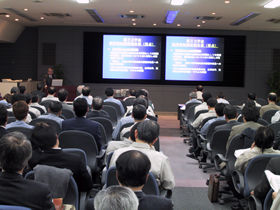|
|
 |
9th Safety Caravan was held on December 7, 2000 at the Toshiba Corporation's Power & Industrial Systems Research & Development Center, and Isogo Nuclear Engineering Center.
|
In the discussion session held at the Toshiba Corporation Power & Industrial Systems Research & Development Center, NSnet introduced its web site for members and safety training materials, and Toshiba discussed its activities, including the "Top Seminar of Nuclear Power" and the "Nippon Atomic Industry Council" A discussion session was then held on safety management activities.
|

Safety presentation
|
The safety presentation was attended by approximately 140 employees from the Isogo Engineering Center and other related companies involved. |
Following a presentation by NSnet on its activities, the lecturer of Japan Atomic Power Company, gave a presentation entitled "Awareness of 'nuclear power Safety Culture' as workers in the nuclear power industry," which included such topics as "Outline of the JCO accident," "Media coverage in the year following the JCO accident," and "Lessons from the Chernobyl reactor accident."
In his presentation, he explained that "The nuclear power Safety Culture is the key to managing safety assurance, fostering ethics and morals, stimulating safety awareness, promoting improvement plans, and passing on accumulated experience and knowledge to the next generation. It is therefore important that industry establish regulations and standards and impart a sense of trust and safety to society."
|
|
Next lecturer of the Electric Power Industry, gave a presentation entitled "Safety and Communication." He discussed the importance of communication in safety, illustrating his point with examples of problems at medical and nuclear power facilities.
In the presentation, it was explained that communication is the most significant factor affecting the progress and outcomes of events, and that, of all factors, it has the greatest effect on safety, both positive and negative. According to the lecturer, it is therefore vital to continuously monitor and analyze the state, flow, and quality of this communication. |
|
|







